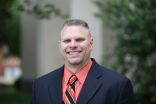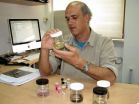(Press-News.org) LIVERMORE, Calif. - Nanoporous metals -- foam-like materials that have some degree of air vacuum in their structure -- have a wide range of applications because of their superior qualities.
They posses a high surface area for better electron transfer, which can lead to the improved performance of an electrode in an electric double capacitor or battery. Nanoporous metals offer an increased number of available sites for the adsorption of analytes, a highly desirable feature for sensors.
Lawrence Livermore National Laboratory (LLNL) and the Swiss Federal Institute of Technology (ETH) researchers have developed a cost-effective and more efficient way to manufacture nanoporous metals over many scales, from nanoscale to macroscale, which is visible to the naked eye.
The process begins with a 4-inch silicon wafer. A coating of metal is added and sputtered across the wafer. Gold, silver and aluminum were used for this research project. However, the manufacturing process is not limited to these metals.
Next, a mixture of two polymers are added to the metal substrate to create patterns, a process known as diblock copolymer lithography (BCP). The pattern is transformed in a single polymer mask with nanometer-size features. Last, a technique known as anisotropic ion beam milling (IBM) is used to etch through the mask to make an array of holes, creating the nanoporous metal.
During the fabrication process, the roughness of the metal is continuously examined to ensure that the finished product has good porosity, which is key to creating the unique properties that make nanoporous materials work. The rougher the metal is, the less evenly porous it becomes.
"During fabrication, our team achieved 92 percent pore coverage with 99 percent uniformity over a 4-in silicon wafer, which means the metal was smooth and evenly porous," said Tiziana Bond, an LLNL engineer who is a member of the joint research team.
The team has defined a metric - based on a parametrized correlation between BCP pore coverage and metal surface roughness - by which the fabrication of nanoporous metals should be stopped when uneven porosity is the known outcome, saving processing time and costs.
"The real breakthrough is that we created a new technique to manufacture nanoporous metals that is cheap and can be done over many scales avoiding the lift-off technique to remove metals, with real-time quality control," Bond said. "These metals open the application space to areas such as energy harvesting, sensing and electrochemical studies."
The lift-off technique is a method of patterning target materials on the surface of a substrate by using a sacrificial material. One of the biggest problems with this technique is that the metal layer cannot be peeled off uniformly (or at all) at the nanoscale.
Other applications of nanoporous metals include supporting the development of new metamaterials (engineered materials) for radiation-enhanced filtering and manipulation, including deep ultraviolet light. These applications are possible because nanoporous materials facilitate anomalous enhancement of transmitted (or reflected) light through the tunneling of surface plasmons, a feature widely usable by light-emitting devices, plasmonic lithography, refractive-index-based sensing and all-optical switching.
INFORMATION:
The other team members include ETH researcher Ali Ozhan Altun and professor Hyung Gyu Park. The team's findings was reported in an article titled "Manufacturing over many scales: High fidelity macroscale coverage of nanoporous metal arrays via lift-off-free nanofrabication." It was the cover story in a recent issue of Advanced Materials Interfaces.
Founded in 1952, Lawrence Livermore National Laboratory provides solutions to our nation's most important national security challenges through innovative science, engineering and technology. Lawrence Livermore National Laboratory is managed by Lawrence Livermore National Security, LLC for the U.S. Department of Energy's National Nuclear Security Administration.
WACO, Texas (Nov. 25, 2014) - Note to venture capitalists: Entrepreneurs are watching to see if you're naughty or nice.
A recently published study of more than 550 decisions and responses from 144 experienced entrepreneurs reveals that "knowledge of explicit ethical or unethical behavior (by venture capitalists) profoundly shapes the entrepreneurs' willingness to partner."
Baylor University researcher Matthew S. Wood, Ph.D., assistant professor of entrepreneurship in Baylor's Hankamer School of Business, co-authored the study, "Take the money or run? Investors' ethical ...
A measles vaccine made of fine dry powder and delivered with a puff of air triggered no adverse side effects in early human testing and it is likely effective, according to a paper to be published November 28 in the journal Vaccine. The paper is now available online.
In 2013, measles killed 145,700 people, most of them children, according to the World Health Organization. That's despite the fact that the conventional injectable vaccine against the measles virus is effective.
"Delivering vaccines in the conventional way, with needle injections, poses some serious challenges, ...
Treatment for obstructive sleep apnea with continuous positive airway pressure (CPAP) or mandibular advancement devices (MADs) can lead to modest improvements in depressive symptoms, according to a study published by Marcus Povitz, Carmelle Bolo, and colleagues from University of Calgary, Canada, in this week's PLOS Medicine.
The researchers identified 22 randomized controlled trials that investigated the effects of CPAP or MAD treatment on patients with obstructive sleep apnea and that measured depressive symptoms before and after treatment. By pooling the results from ...
HOUSTON - (Nov. 25, 2014) - An international collaboration of scientists including Baylor College of Medicine has completed the first genome sequence of a myriapod, Strigamia maritima - a member of a group venomous centipedes that care for their eggs - and uncovered new clues about their biological evolution and unique absence of vision and circadian rhythm.
Over 100 researchers from 12 countries completed the project. They published their work online today in the journal PLOS Biology.
"This is the first myriapod and the last of the four classes of arthropods to have ...
The arthropods are one of Earth's real success stories, with more species of arthropod than in any other animal phylum, but our knowledge of arthropod genomes has been heavily skewed towards the insects. Recent work has furnished us with the genome sequences of an arachnid and a crustacean, but the myriapods (centipedes and millipedes) have remained the one class of arthropods whose genomes are still in the dark.
An international team of scientists (over 100 from 15 countries) with Stephen Richards (Baylor College of Medicine) as senior author has now sequenced the genome ...
Centipedes, those many-legged creatures that startle us in our homes and gardens, have been genetically sequenced for the first time. In a new study in the journal PLoS Biology, an international team of over 100 scientists today reveals how this humble arthropod's DNA gave them new insight into how life developed on our planet.
Centipedes are members of the arthropods, a group with numerous species including insects, spiders and other animals. Until now, the only class of arthropods not represented by a sequenced genome was the myriapods, which include centipedes and ...
Learning-related brain activity in Parkinson's patients improves as much in response to a placebo treatment as to real medication, according to a new study by researchers at the University of Colorado Boulder and Columbia University.
Past research has shown that while Parkinson's disease is a neurological reality, the brain systems involved may also be affected by a patient's expectations about treatment. The new study, published in the journal Nature Neuroscience, explains how the placebo treatment -- when patients believe they have received medication when they have ...
Endangered Snake River sockeye salmon are regaining the fitness of their wild ancestors, with naturally spawned juvenile sockeye migrating to the ocean and returning as adults at a much higher rate than others released from hatcheries, according to a newly published analysis. The analysis indicates that the program to save the species has succeeded and is now shifting to rebuilding populations in the wild.
Biologists believe the increased return rate of sockeye spawned naturally by hatchery-produced parents is high enough for the species to eventually sustain itself in ...
MAYWOOD, Il. - An award-winning study by a Loyola University Chicago Stritch School of Medicine researcher has documented how homeless, mentally ill women in India face a vicious cycle:
During psychotic episodes, they wander away from home, sometimes for long distances, and wind up in homeless shelters. They then are returned to their families before undergoing sufficient psychosocial rehabilitation to deal with their illness. Consequently, they suffer mental illness relapses and wind up homeless again.
"The study illustrates how there must be a balance between reintegrating ...
While the turkey you eat on Thursday will bring your stomach happiness and could probably kick-start an afternoon nap, it may also save your life one day.
That's because the biological machinery needed to produce a potentially life-saving antibiotic is found in turkeys. Looks like there is one more reason to be grateful this Thanksgiving.
"Our research group is certainly thankful for turkeys," said BYU microbiologist Joel Griffitts, whose team is exploring how the turkey-born antibiotic comes to be. "The good bacteria we're studying has been keeping turkey farms healthy ...


